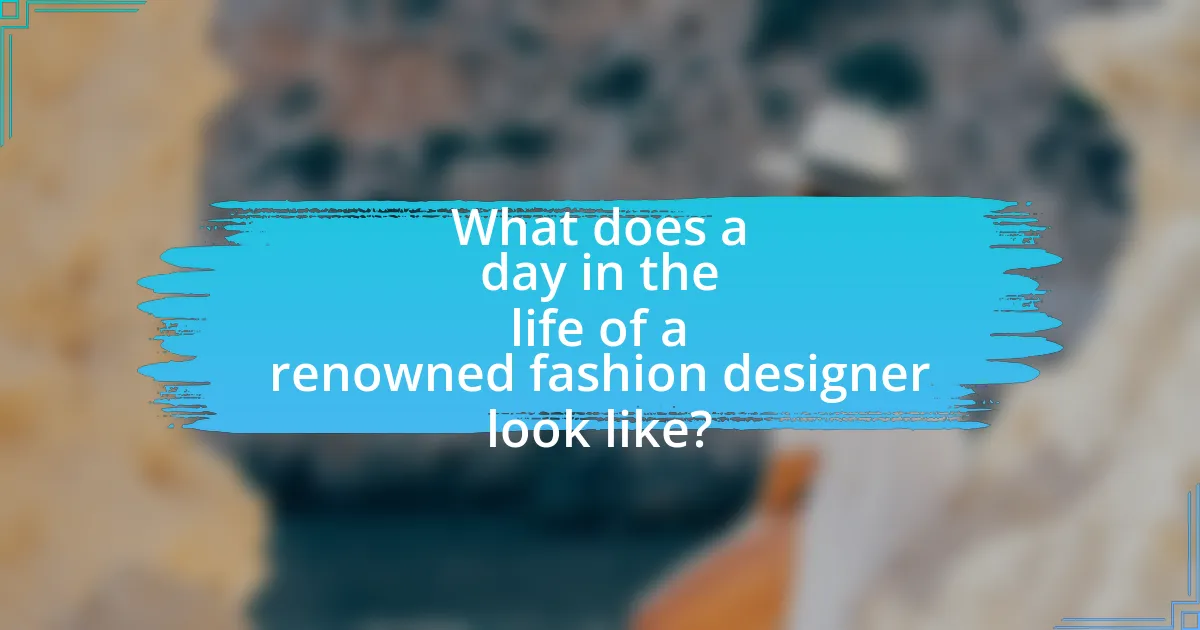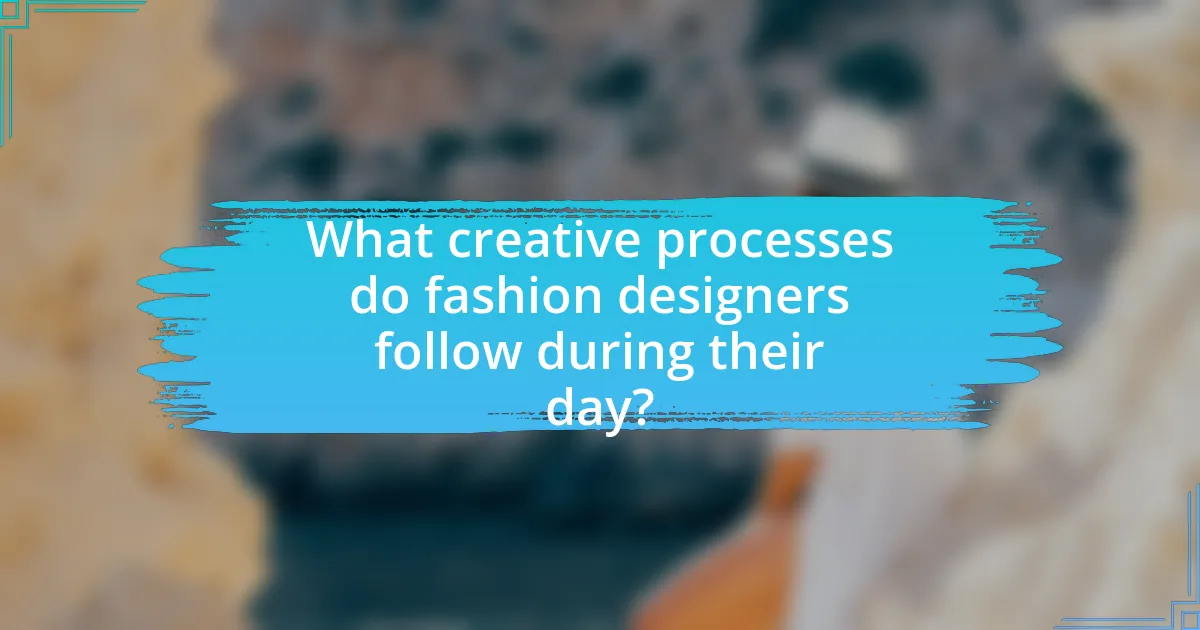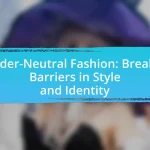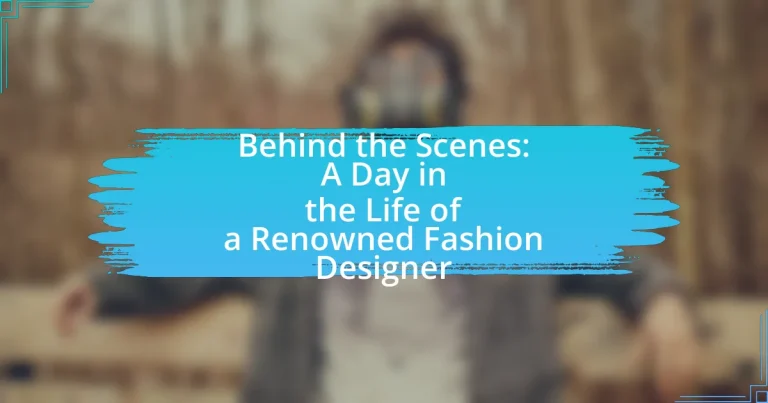The article “Behind the Scenes: A Day in the Life of a Renowned Fashion Designer” provides an in-depth look at the daily routines and responsibilities of successful fashion designers. It outlines their structured schedules, which include creative tasks such as sketching and fabric selection, as well as administrative duties like meetings and client interactions. The piece highlights the importance of collaboration, time management, and the challenges designers face, such as tight deadlines and creative blocks. Additionally, it discusses the tools and techniques designers use to generate ideas and the significance of fabric selection in their work. Overall, the article emphasizes the blend of creativity and business acumen required to thrive in the fashion industry.

What does a day in the life of a renowned fashion designer look like?
A day in the life of a renowned fashion designer typically involves a structured schedule filled with creative and administrative tasks. The designer begins the day early, often reviewing emails and messages from clients, suppliers, and team members to stay updated on ongoing projects. Following this, they may spend several hours sketching new designs or refining existing concepts, which is crucial for upcoming collections.
Meetings with their design team are common, where they discuss fabric choices, color palettes, and production timelines. These collaborative sessions are essential for ensuring that the vision aligns with practical execution. Additionally, renowned designers often visit fabric suppliers or manufacturers to source materials, which is vital for maintaining quality and innovation in their work.
Throughout the day, they may also engage in fittings with models to ensure that garments fit perfectly and make necessary adjustments. This hands-on approach is critical for achieving the desired aesthetic and functionality in their designs. Networking events, fashion shows, or promotional activities may fill the latter part of the day, allowing designers to showcase their work and connect with industry professionals.
In summary, a renowned fashion designer’s day is a blend of creativity, collaboration, and business management, all aimed at producing high-quality fashion that resonates with their audience.
How do fashion designers start their day?
Fashion designers typically start their day with a structured morning routine that often includes reviewing their schedules, checking emails, and gathering inspiration for their designs. This routine is crucial as it sets the tone for a productive day filled with creative tasks and meetings. Many designers also engage in activities such as sketching ideas or reviewing fabric swatches to stimulate their creativity and prepare for upcoming projects.
What morning routines are common among successful fashion designers?
Successful fashion designers commonly start their mornings with a structured routine that includes exercise, meditation, and reviewing their schedules. Many successful designers prioritize physical activity, such as yoga or running, to boost energy and creativity for the day ahead. Additionally, meditation is often incorporated to enhance focus and mental clarity, which is crucial in the fast-paced fashion industry. Reviewing their schedules and setting daily goals is also a common practice, allowing designers to stay organized and aligned with their creative vision. These routines are supported by insights from interviews and biographies of prominent designers, highlighting the importance of discipline and mindfulness in their daily lives.
How does a designer prepare for the day ahead?
A designer prepares for the day ahead by organizing their schedule, reviewing project timelines, and gathering necessary materials. This preparation often includes setting specific goals for the day, such as completing design sketches or meeting with team members. Additionally, designers may spend time researching trends and gathering inspiration to inform their work, ensuring they stay current in the fast-paced fashion industry. This structured approach allows designers to maximize productivity and creativity throughout their day.
What are the key responsibilities of a fashion designer throughout the day?
The key responsibilities of a fashion designer throughout the day include sketching designs, selecting fabrics, creating patterns, and overseeing the production process. Fashion designers begin their day by brainstorming and sketching new ideas, which helps them visualize their concepts. They then choose appropriate fabrics and materials, ensuring that their selections align with the design vision and market trends. After fabric selection, designers create patterns that serve as templates for garment construction. Additionally, they collaborate with production teams to oversee the manufacturing process, ensuring quality and adherence to design specifications. This multifaceted role requires a blend of creativity and technical skills, as designers must stay updated on industry trends and consumer preferences to remain competitive.
How do designers balance creativity and business tasks?
Designers balance creativity and business tasks by integrating structured processes that allow for both innovative design and effective management. They often allocate specific time blocks for creative brainstorming and separate periods for administrative duties, ensuring that neither aspect overshadows the other. For instance, a study by the Design Management Institute found that companies that prioritize design-driven strategies see a 228% higher return on investment compared to those that do not, highlighting the importance of balancing these elements for overall success.
What role does collaboration play in a designer’s daily activities?
Collaboration is essential in a designer’s daily activities as it fosters creativity and innovation. Designers work closely with various stakeholders, including clients, team members, and suppliers, to gather diverse perspectives and insights that enhance the design process. For instance, a study by the Design Management Institute found that companies with a strong collaborative culture are 5 times more likely to be high-performing. This collaborative approach allows designers to refine their ideas, address challenges effectively, and ensure that the final product aligns with the vision and needs of all parties involved.
What challenges do fashion designers face during their daily routines?
Fashion designers face numerous challenges during their daily routines, including time management, creative blocks, and the pressure to meet client expectations. Time management is critical as designers juggle multiple projects, deadlines, and meetings, often leading to stress and burnout. Creative blocks can hinder the design process, making it difficult to generate new ideas or concepts, which is essential in a fast-paced industry. Additionally, the pressure to satisfy client demands and stay relevant in a competitive market can create significant stress, impacting both the quality of work and the designer’s mental well-being. These challenges are compounded by the need to adapt to rapidly changing fashion trends and consumer preferences, requiring designers to remain innovative and flexible.
How do designers handle tight deadlines and pressure?
Designers handle tight deadlines and pressure by employing effective time management strategies and prioritizing tasks. They often break projects into smaller, manageable parts, allowing them to focus on one aspect at a time, which reduces overwhelm. Additionally, designers frequently utilize tools such as project management software to track progress and deadlines, ensuring that they stay organized and on schedule. Research indicates that 70% of designers report that setting clear goals and deadlines significantly enhances their productivity under pressure. By maintaining open communication with team members and clients, designers can also clarify expectations and make necessary adjustments, further alleviating stress.
What are common obstacles in the design process?
Common obstacles in the design process include time constraints, budget limitations, and communication issues among team members. Time constraints often lead to rushed decisions, which can compromise the quality of the design. Budget limitations restrict the materials and resources available, impacting the overall creativity and execution of the design. Communication issues can result in misunderstandings and misalignment of vision, hindering collaboration and the final outcome. These obstacles are frequently cited in industry reports, such as the “Design Management Institute’s Design Value Index,” which highlights the importance of effective project management and clear communication in overcoming these challenges.

How do fashion designers interact with their teams and clients?
Fashion designers interact with their teams and clients through collaborative meetings, feedback sessions, and presentations. Designers often hold regular team meetings to discuss project progress, share ideas, and delegate tasks, ensuring that everyone is aligned with the creative vision. They also engage in feedback sessions with clients to understand their preferences and requirements, which helps in tailoring designs to meet client expectations. This interaction is crucial for maintaining a cohesive workflow and fostering creativity, as evidenced by the practice of renowned designers who frequently involve their teams in brainstorming sessions to enhance innovation and problem-solving.
What is the importance of teamwork in a fashion designer’s day?
Teamwork is crucial in a fashion designer’s day as it fosters collaboration, enhances creativity, and ensures efficient workflow. Designers rely on a diverse team, including pattern makers, seamstresses, and marketing professionals, to bring their visions to life. This collaborative effort allows for the sharing of ideas, which can lead to innovative designs and solutions to challenges. For instance, a study by the Fashion Institute of Technology highlights that projects involving cross-functional teams are 30% more likely to succeed in meeting deadlines and quality standards. Thus, effective teamwork not only streamlines the design process but also significantly contributes to the overall success of fashion projects.
How do designers communicate their vision to their teams?
Designers communicate their vision to their teams through visual presentations, detailed sketches, and collaborative discussions. These methods allow designers to convey their ideas clearly and ensure that all team members understand the intended aesthetic and functional goals of a project. For instance, using mood boards and prototypes helps to visually represent concepts, making it easier for team members to grasp the designer’s vision. Additionally, regular meetings and feedback sessions foster open communication, allowing for adjustments and refinements based on team input, which is crucial in the fast-paced fashion industry.
What roles do assistants and interns play in a designer’s workflow?
Assistants and interns play crucial roles in a designer’s workflow by providing support in various tasks that enhance productivity and creativity. Assistants often manage administrative duties, coordinate schedules, and facilitate communication between team members, allowing designers to focus on the creative aspects of their work. Interns, on the other hand, typically engage in hands-on tasks such as fabric sourcing, sketching, and assisting during fittings, which helps them gain practical experience while contributing to the design process. This collaborative dynamic not only streamlines operations but also fosters a learning environment that benefits both the designer and the supporting staff.
How do fashion designers engage with clients and stakeholders?
Fashion designers engage with clients and stakeholders through direct communication, collaborative projects, and feedback mechanisms. They often hold meetings, presentations, and fittings to understand client preferences and gather input, ensuring that the final designs align with expectations. Additionally, designers utilize social media and digital platforms to showcase their work and interact with a broader audience, fostering relationships with both clients and industry stakeholders. This engagement is crucial for building brand loyalty and adapting to market trends, as evidenced by the increasing use of customer feedback in design iterations, which has been shown to enhance customer satisfaction and sales.
What types of meetings do designers typically have with clients?
Designers typically have several types of meetings with clients, including initial consultations, design presentations, feedback sessions, and final reviews. Initial consultations allow designers to understand client needs and project scope, while design presentations showcase proposed concepts and gather client input. Feedback sessions are crucial for refining designs based on client reactions, and final reviews ensure that the completed work aligns with client expectations. These meetings are essential for effective communication and collaboration throughout the design process.
How do designers incorporate client feedback into their work?
Designers incorporate client feedback into their work by actively soliciting input throughout the design process and making adjustments based on that feedback. They often conduct meetings or surveys to gather client preferences and critiques, which are then analyzed to inform design revisions. For instance, a study published in the Journal of Design Research highlights that iterative feedback loops significantly enhance client satisfaction and project outcomes, demonstrating the effectiveness of integrating client insights into design iterations.

What creative processes do fashion designers follow during their day?
Fashion designers typically follow a structured creative process that includes research, sketching, fabric selection, and prototyping. Initially, designers conduct research to gather inspiration from various sources such as art, culture, and current trends. This research informs their design concepts. Following this, designers create sketches to visualize their ideas, often using digital tools or traditional methods.
Next, they select fabrics and materials that align with their vision, considering texture, color, and sustainability. After finalizing the materials, designers create prototypes or samples to test the fit and functionality of their designs. This iterative process may involve multiple revisions based on feedback and practical testing.
These steps are essential for translating creative ideas into tangible fashion products, ensuring that the final designs meet both aesthetic and practical standards.
How do designers generate and develop new ideas?
Designers generate and develop new ideas through a combination of research, brainstorming, and experimentation. They often begin by analyzing current trends, cultural influences, and consumer needs, which informs their creative direction. For instance, a study published in the Journal of Fashion Marketing and Management highlights that successful designers frequently engage in trend forecasting and market analysis to identify emerging styles and consumer preferences. This foundational research is complemented by brainstorming sessions, where designers collaborate with teams to explore various concepts and themes. Additionally, prototyping and iterative design processes allow designers to test and refine their ideas, ensuring that the final product resonates with their target audience.
What techniques do designers use for inspiration?
Designers use various techniques for inspiration, including mood boards, sketching, and research. Mood boards allow designers to visually compile images, colors, and textures that evoke a specific theme or concept, facilitating creative exploration. Sketching serves as a fundamental practice for designers to quickly capture ideas and iterate on concepts. Researching trends, historical references, and cultural influences provides context and depth, enabling designers to create relevant and innovative designs. These techniques are widely recognized in the fashion industry, as they help translate abstract ideas into tangible creations.
How do mood boards and sketches play a role in the design process?
Mood boards and sketches are essential tools in the design process, serving as visual representations of concepts and ideas. Mood boards compile images, colors, textures, and typography to convey the overall aesthetic and emotional direction of a project, helping designers establish a cohesive vision. Sketches, on the other hand, allow designers to explore and refine their ideas through quick illustrations, enabling them to visualize garment shapes, patterns, and details before moving to more detailed designs. Together, these tools facilitate communication among team members and stakeholders, ensuring that everyone shares a common understanding of the design intent, which is crucial for successful project execution.
What tools and technologies do fashion designers utilize?
Fashion designers utilize a variety of tools and technologies, including design software, sewing machines, and fabric manipulation tools. Design software such as Adobe Illustrator and CAD (Computer-Aided Design) programs allow designers to create digital sketches and patterns, streamlining the design process. Sewing machines, both industrial and domestic, are essential for constructing garments, while tools like scissors, measuring tapes, and pattern weights assist in fabric cutting and manipulation. The integration of 3D printing technology is also becoming prevalent, enabling designers to create prototypes and intricate designs with precision. These tools and technologies enhance creativity and efficiency in the fashion design process.
How do software programs assist in the design process?
Software programs assist in the design process by providing tools for visualization, simulation, and collaboration. These programs enable designers to create detailed digital models and prototypes, allowing for immediate adjustments and iterations. For instance, CAD (Computer-Aided Design) software allows fashion designers to draft patterns and visualize garments in 3D, enhancing accuracy and reducing material waste. Additionally, software like Adobe Illustrator facilitates the creation of intricate designs and graphics, streamlining the workflow. The integration of these technologies has been shown to increase efficiency in the design process, with studies indicating that digital tools can reduce design time by up to 30%.
What is the significance of fabric selection in a designer’s work?
Fabric selection is crucial in a designer’s work as it directly influences the garment’s aesthetic, functionality, and overall quality. The choice of fabric affects how a design drapes, moves, and interacts with the body, which can enhance or detract from the intended visual impact. For instance, lightweight fabrics like chiffon create a soft, flowing silhouette, while structured materials like denim provide durability and shape. Additionally, the fabric’s texture, color, and pattern contribute to the emotional response of the audience, making it a key element in conveying the designer’s vision. Historical examples, such as Coco Chanel’s use of jersey fabric to revolutionize women’s fashion, illustrate how fabric selection can redefine style and comfort in the industry.
What are some best practices for aspiring fashion designers?
Aspiring fashion designers should focus on continuous learning and skill development. Engaging in formal education, such as fashion design programs, provides foundational knowledge in design principles, textiles, and garment construction. Additionally, gaining practical experience through internships or apprenticeships with established designers enhances technical skills and industry understanding. Networking within the fashion community is crucial, as building relationships can lead to collaboration opportunities and mentorship. Staying updated on fashion trends and market demands through research and attending industry events is essential for relevance. Furthermore, developing a unique personal style and portfolio showcases creativity and attracts potential employers or clients. These practices are supported by the fact that many successful designers, such as Alexander McQueen and Stella McCartney, emphasize the importance of education and networking in their careers.
How can new designers effectively manage their time and tasks?
New designers can effectively manage their time and tasks by implementing structured planning and prioritization techniques. Utilizing tools such as digital calendars and task management apps allows designers to allocate specific time slots for design work, meetings, and deadlines, ensuring that they stay organized. Research indicates that individuals who use time management tools report a 25% increase in productivity, highlighting the effectiveness of these strategies. Additionally, adopting the Eisenhower Matrix helps designers distinguish between urgent and important tasks, enabling them to focus on what truly matters in their workflow.
What strategies can help designers stay inspired and innovative?
Designers can stay inspired and innovative by engaging in continuous learning and exploration of diverse influences. This includes attending workshops, participating in design competitions, and collaborating with other creatives, which fosters new ideas and perspectives. Research indicates that exposure to varied artistic disciplines enhances creativity; for instance, a study published in the Journal of Creative Behavior found that interdisciplinary collaboration significantly boosts innovative thinking among designers. Additionally, maintaining a routine that incorporates regular breaks and time for reflection allows designers to recharge and cultivate fresh concepts.

















